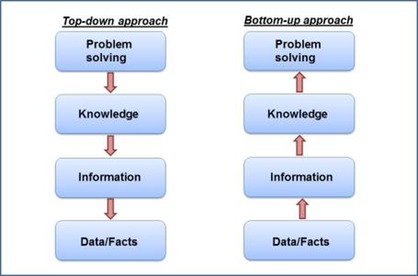Should your approach to analytics be top-down (strategic) or bottom-up (operational)? Both approaches have merit, but I would argue that you shouldn't rely on just one. To understand the difference between the two approaches, look at the image below; this figure (and the entire idea for this entry), comes from Morten Kamp's "All About Human Capital" blog.

Many take the bottom-up approach, perhaps because it is easier. They look through their available data (or "Big Data" for some) and look for ways to measure, visualize, and trend it, looking for links between the data and things they think are important. OK; there's some value there, in that good analytics from a bottom-up strategy can show you connections you hadn't seen before and maybe even challenge your business strategy.
In comparison, the top-down approach starts with the business strategy and looks for areas to focus operational efforts. Then, you find the desired knowledge you require to make the right decision. The you design the data required to provide you with this knowledge.
Bottom line … analytics is one tool to help leaders make better decisions. Depending on the type of decisions you are making (i.e. strategic or operational), your approach to analytics must also change. Don’t just look at the data you currently have (but do that too); instead what data you need to create the most value from your analytics effort.
